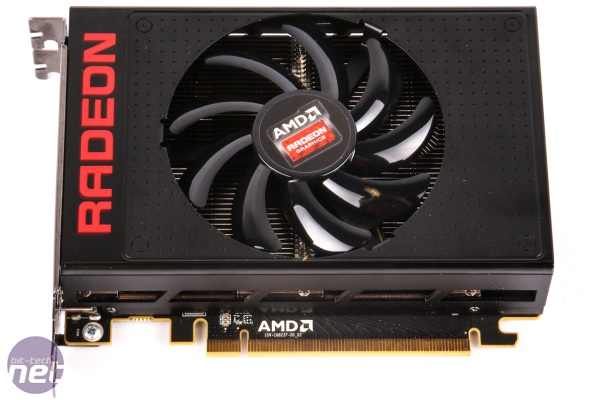
AMD Radeon R9 Nano 4GB Review
Manufacturer: AMDUK price (as reviewed): Approx. £530 (inc VAT)
US price (as reviewed): MSRP $649 (ex Tax)

AMD's newest Fiji GPU has powered two graphics cards, the R9 Fury X and the R9 Fury, while the Fiji card, the R9 Nano, officially launches today. The R9 Nano takes a notably different stance to the Fury graphics cards with a focus on being ultra compact and significantly more power efficient, rather than targeting all-out performance like the R9 Fury X. The compactness of the AMD R9 Nano is facilitated by the all-in-one design of AMD's Fiji GPU that sees the HBM memory and the GPU core placed on the same ASIC. In total, the R9 Nano measures in at only 6-inches in length making it the shortest card of its performance class.
The power efficiency of the R9 Nano is achieved in a somewhat unconventional way. Rather than opting for a cut-down GPU die AMD harnesses the full extent of the Fiji GPU - all 4,096 GCN cores - and reduces frequencies compared to the flagship R9 Fury X to conserve power. Combining reduced clock speeds with a bespoke power management algorithm, the R9 Nano promises a 100W reduction in the TDP of the Fiji GPU. The comparatively modest 175W TDP allows AMD to easily tame the R9 Nano with a single-fan, dual-slot air cooling solution.
| AMD Radeon R9 Nano 4GB | AMD Radeon R9 Fury X 4GB | Nvidia GeForce GTX 970 4GB | Asus GeForce GTX 970 DirectCU Mini 4GB | |
| GPU | ||||
| Architecture | Graphics Core Next | Graphics Core Next | Maxwell | Maxwell |
| Codename | Fiji | Fiji | GM204 | GM204 |
| Core Clock | Up to 1,000MHz | Up to 1,050MHz | 1,050MHz (Base) 1,178MHz (Boost) | 1,088MHz (Base) 1,228MHz (Boost) |
| Cores | 4,096 | 4,096 | 1,664 | 1,664 |
| Texture Units | 256 | 256 | 104 | 104 |
| ROPs | 64 | 64 | 56 | 56 |
| Transistors | 8.9 billion | 8.9 billion | 5.2 billion | 5.2 billion |
| Die Size | 596mm2 | 596mm2 | 398mm2 | 398mm2 |
| Process Node | 28nm | 28nm | 28nm | 28nm |
| Memory | ||||
| Amount | 4GB HBM | 4GB HBM | 4GB GDDR5 | 4GB GDDR5 |
| Frequency | 500MHz (1GHz effective) | 500MHz (1GHz effective) | 7,010MHz effective | 7,010MHz effective |
| Interface | 4,096-bit | 4,096-bit | 256-bit | 256-bit |
| Bandwidth | 512GB/sec | 512GB/sec | 224GB/sec | 224GB/sec |
| Card Specifications | ||||
| Power Connectors | 1 x 8-pin | 2 x 8-pin | 2 x 6-pin | 1 x 8-pin |
| Stock Card Length | 152mm | 195mm | N/A | 170mm |
| TDP | 175W | 275W | 145W | 145W |
The R9 Nano follows similar aesthetics to the R9 Fury X with a focus on what AMD terms a 'premium industrial design'. In short, this entails building the R9 Nano from premium materials like brushed aluminium, an all-metal shroud and a matt black PCB. The R9 Nano is, without doubt, a sturdily built graphics card that feels and looks the part for its performance segment. AMD is so confident in its reference design that, in a similar fashion to the R9 Fury X, non-reference versions will not be permitted by AMD partners, although we could still see third-party water blocks.

The closest competition to the R9 Nano from Nvidia, at the time of writing, are the compact variations of the GTX 970. Asus currently offers the GTX 970 DirectCU Mini measuring in at 170mm, which we have retested for this review, while Gigabyte offers its GTX 970 OC ITX that is 183mm long. Interestingly, that means the R9 Nano is still a healthy 18mm shorter than its closest rival albeit with an important caveat; the $649 MSRP of the R9 Nano is almost twice as much as the $349 commanded by compact GTX 970s. AMD claims to compensate for this by offering more performance, particularly at higher resolutions, so let's assess the AMD R9 Nano in our suite of benchmarks.


MSI MPG Velox 100R Chassis Review
October 14 2021 | 15:04








Want to comment? Please log in.